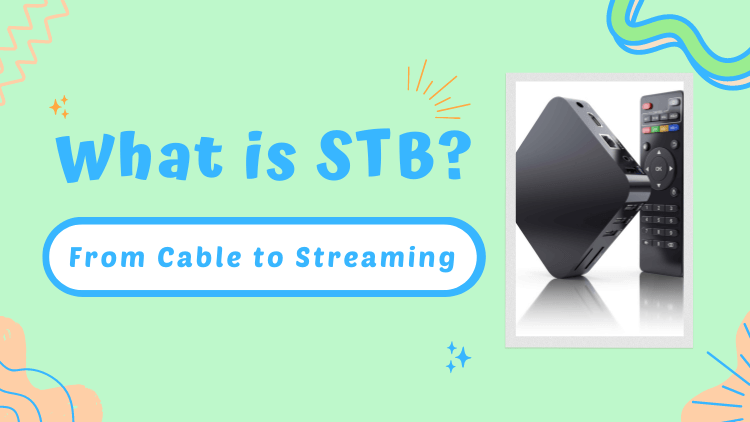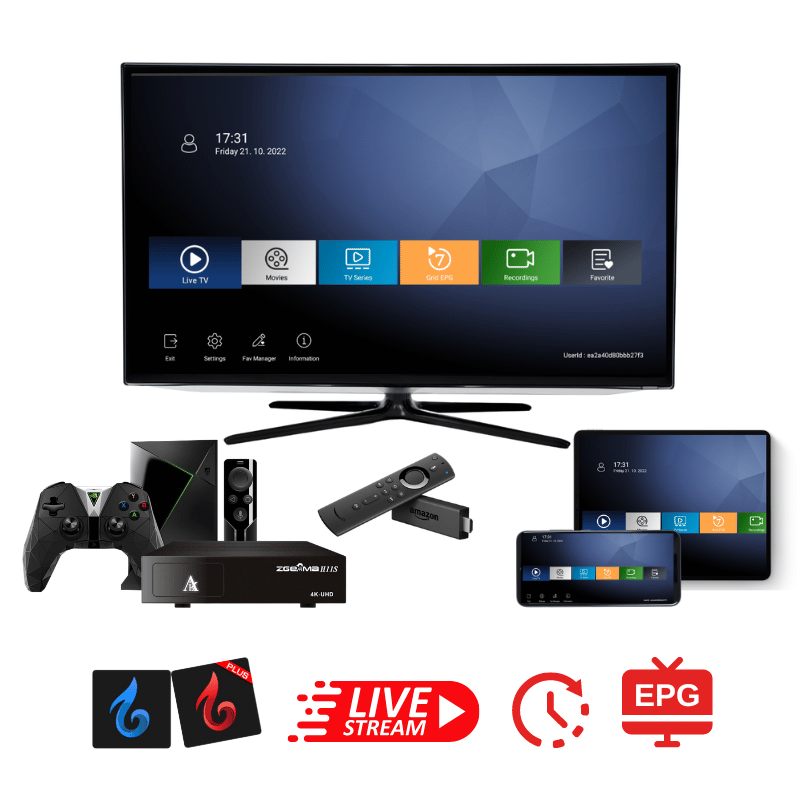The rapidly evolving digital entertainment industry has led to a significant surge in the popularity of IPTV subscription services. The Set-Top Box (STB) forms the foundation of the IPTV experience. Whether you are new to IPTV or seeking to enhance your knowledge of this technology, this article presents a fundamental introduction to STBs and shares valuable insights for the year 2023.



What is STB?
A Set-Top Box (STB) is a nifty device that connects to your television and does some digital magic. It acts as a bridge between your TV and various content sources like cable, satellite, or internet-based services. Its main job is to take those digital signals and transform them into a format that your TV can display. You’ll usually find STBs using HDMI or composite video cables to show you the visuals, while the audio comes out through RCA or digital audio connectors.
STBs come in different flavors depending on where the content comes from. Cable TV STBs are given to you by your cable provider to decode and receive cable television signals. Satellite TV STBs are your go-to if you want to receive and decode signals from satellite providers. And then there are the awesome IPTV STBs that let you stream television content over an internet connection.
But wait, there’s more! Modern STBs are not just one-trick ponies. They come with exciting extras like electronic program guides (EPG), video-on-demand services, and the power to pause, rewind, or record live TV. Some super advanced STBs even have internet access, so you can explore online apps, streaming services, and interactive content, all from the comfort of your couch.
Sure, there’s competition from smart TVs, streaming devices, and over-the-top services, but STBs are still rocking the traditional television scene. They’ve transformed over time, becoming smaller, smarter, and more integrated with other devices. Nowadays, many smart TVs even have built-in STB capabilities, eliminating the need for a separate device. But guess what? STBs are still holding their ground and playing a major role in delivering and elevating TV content for households all around the world.



3-Day IPTV Free Trial
- 1300+ Live TV
- 3000+ VOD Movies & Sports Events
- TV Guide (EPG)
- Plus with Catch Up & Cloud PVR
- Reliable & Stable Server
- Available for Android & Firestick
- Instant Activation, No CC
Features of STB
- Signal Reception and Decoding: The STB acts as a digital wizard, receiving and decoding television signals from cable, satellite, or internet-based services. It works behind the scenes to convert those signals into a TV-friendly format, bringing your favorite shows and movies to life on the big screen.
- Video Output: With its array of video output options like HDMI, composite video, or component video connections, the STB ensures a visual feast for your eyes. It delivers high-quality video transmission, making every scene crisp, vibrant, and immersive.
- Audio Output: Prepare for an auditory delight! The STB offers multiple audio output options, including RCA connectors or digital audio connections (S/PDIF). This ensures optimal audio transmission, allowing you to enjoy the rich sound of movies, music, and more through your audio devices.
- Interactive Program Guide (EPG): Bid farewell to channel confusion! The STB’s interactive program guide (EPG) is your TV companion, providing a user-friendly interface that showcases current and upcoming programs. Easily browse channels, read program descriptions, and schedule recordings, all at your fingertips.
- Video-on-Demand (VOD): Instant gratification at its finest! The STB supports video-on-demand (VOD), letting you dive into a vast library of movies, TV shows, and other video content whenever you please. Enjoy the freedom to select and stream your favorites instantly, transforming your TV into an entertainment hub.
- Time-Shifting and Recording: Never miss a moment with the STB’s time-shifting and recording capabilities. Capture live TV programs for later viewing, and enjoy the flexibility to pause, rewind, or fast-forward through live broadcasts. It’s like having your personal time-traveling remote!
- Internet Connectivity: The STB opens the door to a world of online entertainment. With its internet connectivity, you can access a variety of online applications, streaming services, and interactive content. Browse the web, connect with social media, and indulge in streaming platforms, all from the comfort of your couch.
- Parental Controls: Take charge of what your family watches with the STB’s built-in parental control features. Safeguard your little ones by restricting access to specific channels or content, ensuring a safe and controlled viewing environment tailored to your family’s values.
- Interactive Applications: Expand your TV experience with the STB’s interactive applications and widgets. Get live weather updates, stay up-to-date with news, check sports scores, and seamlessly integrate social media. It’s an all-in-one entertainment package that keeps you informed and engaged.
- Connectivity Options: The STB doesn’t stop at television alone. It offers versatile connectivity options like USB ports, Ethernet ports, or Wi-Fi, allowing you to connect external storage devices, wireless adapters, or peripherals. Unlock additional functionality and customize your setup to suit your needs.
Remember, the specific features may vary depending on the model and type of Set-Top Box, but they all strive to enhance your television viewing experience in delightful ways.
The advantages of using STB
Reaping the rewards of STB technology unlocks a plethora of benefits for your entertainment journey. From seamless signal reception and elevated video quality to interactive functionalities and effortless access to on-demand content, the advantages of embracing STB are abundant.
| Advantages | Description |
|---|---|
| Access to digital television signals | Receive and decode digital TV signals for high-quality video and audio transmission. |
| Wide range of channels and content | Access diverse channels and content from different service providers. |
| Enhanced viewing experience | Enjoy advanced features like pausing, rewinding, and program guides for easy show scheduling. |
| Video-on-Demand (VOD) services | Access a vast library of movies, TV shows, and video content for on-demand viewing. |
| Interactive and online capabilities | Connect to the internet, access online applications, and stream content from various platforms. |
| Recording and time-shifting | Record favorite shows for later viewing and utilize time-shifting features for live TV control. |
| Parental control and content filtering | Restrict access to specific channels or content based on ratings or criteria for family-friendly viewing. |
| Connectivity options | Connect with external devices using USB, Ethernet, or Wi-Fi connectivity for expanded functionality. |
| Integration with other devices | Seamlessly integrate with home theater systems, gaming consoles, and smart TVs for enhanced experience. |
| Continuous technological advancements | Benefit from regular updates and improvements in STB technology for the latest features and advancements. |
Evolution of STB
STBs have evolved from basic reception devices to versatile entertainment hubs, offering improved picture quality, interactive features, and integration with smart TVs.
Historical development of STBs
The Set-Top Box (STB) has come a long way, evolving into a versatile entertainment powerhouse. Initially introduced for better reception and tuning, STBs quickly adapted to the digital era. Digital STBs improved picture quality and introduced electronic program guides (EPG). As cable and satellite TV gained popularity, dedicated STBs emerged to decode signals from providers. Interactive features and services like video-on-demand (VOD) and online applications were later integrated.
Advancements and Impact
Technological advancements have revolutionized STBs. High-definition (HD) STBs catered to the demand for better visuals. Digital video recorders (DVRs) allowed users to record and store their favorite shows. IPTV STBs enabled streaming over IP networks. The rise of OTT services brought streaming devices with access to multiple platforms. Features like 4K resolution, HDR, voice control, and AI integration continue to shape STB technology.
Integration with Smart TVs and Devices
STB functionality has found its way into smart TVs and other devices. Many modern smart TVs have built-in STB capabilities, streamlining the viewing experience. STBs also integrate with home theater systems, gaming consoles, and soundbars, creating a unified entertainment setup. This integration offers convenience and access to a wide range of content and services through a single device or interface.
In summary, the historical development, technological advancements, and integration with smart TVs and devices have propelled STBs into versatile entertainment hubs. From basic reception to a multitude of features, STBs have evolved to provide users with an immersive and convenient way to enjoy their favorite content.
STB Challenges and Future Outlook
1. Competition from alternative platforms
Set-Top Boxes (STBs) face competition from smart TVs and streaming devices that offer integrated streaming capabilities and direct access to streaming services. STBs must innovate and offer unique features to remain relevant in the market.
2. Evolving consumer preferences and demands
Changing consumer preferences and demands for personalized content and flexible access require STBs to adapt. They need to provide seamless integration with streaming platforms, personalized recommendations, and user-friendly interfaces.
3. Potential advancements and future prospects of STB
- Enhanced Integration: STBs can integrate with smart home devices, offering voice control and compatibility with emerging technologies like VR or AR.
- Improved Content Discovery: Leveraging machine learning and AI algorithms, STBs can provide accurate and personalized content recommendations.
- 5G and IoT Connectivity: With 5G networks and IoT devices, STBs can enable seamless streaming, cloud-based storage, and enhanced interactive features.
- Hybrid Solutions: STBs can integrate traditional broadcast channels and online streaming services, providing convenience and flexibility.
- Energy Efficiency and Sustainability: Future STBs can focus on energy-efficient designs and eco-friendly manufacturing practices.
The future prospects of STBs depend on their ability to adapt to consumer demands, embrace technology advancements, and provide unique features and integration capabilities. By staying competitive, catering to consumer preferences, and exploring new opportunities, STBs can continue to play a crucial role in delivering entertainment content to households worldwide.
Video – Definition of What is Setup Boxes(STB)
Check out our video that provides a clear explanation of Set-Top Boxes (STBs). It offers a comprehensive understanding of STBs and enriches your knowledge on the topic.
Related reading:
Install IPTV GTV on Your Mi Box for the Best TV
EPG Demystified: The Electronic Program Guide
Detailed steps: Install GTV APP on your Android phone
How to clear the cache on the IPTV app – GTV Guide
What are the types of STB?
When it comes to Set-Top Boxes (STBs), there is a wide range of options to choose from, each tailored to specific needs and preferences. Familiarizing yourself with the different types of STBs is crucial in selecting the right device that aligns with your viewing habits and content sources. Whether you rely on cable, satellite, or internet-based services, exploring the various types of STBs will offer valuable insights into the diverse options available to enhance your television experience.
Here’s a table summarizing the types of Set-Top Boxes (STBs) and their corresponding descriptions:
| Type | Description |
|---|---|
| Cable STB | Receives and decodes television signals from cable providers, offering access to a wide range of cable channels and services. |
| Satellite STB | Receives and decodes signals from satellite television providers, allowing users to access satellite TV channels and services. |
| IPTV STB | Streams television services over IP networks, providing on-demand content, live TV streaming, and interactive features. |
| Hybrid STB | Combines different technologies (terrestrial, cable, satellite, internet) to access multiple sources through a single device. |
| OTT STB | Also known as streaming devices, provides direct access to over-the-top streaming services like Netflix, Amazon Prime Video, etc. |
| Digital Terrestrial | Receives and decodes digital over-the-air television signals, commonly used in areas with digital terrestrial broadcasting. |
| Free-to-Air STB | External devices transform regular TVs into smart TVs, providing internet connectivity and access to streaming services. |
| HD STB | Supports high-definition television signals, providing enhanced video and audio quality for high-resolution content. |
| DVR STB | Equipped with built-in storage and recording capabilities, allowing users to record and store their favorite TV shows. |
| Smart TV STB | External devices that transform regular TVs into smart TVs, providing internet connectivity and access to streaming services. |
Set-Top Boxes (STBs) come in various types, each catering to different content sources and viewing preferences. Cable TV STBs are specifically designed to decrypt and receive cable television signals, while satellite TV STBs excel at receiving and decoding signals from satellite providers. IPTV STBs, on the other hand, enable the streaming of television content over an internet connection. Each type of STB boasts unique features and capabilities, providing users with access to a diverse range of channels and services. Understanding the distinctions among the different types of STBs empowers individuals to select the device that best suits their specific entertainment needs.
FAQ
What does the STB do?
A Set-Top Box (STB) is a device that bridges your television to the world of digital entertainment. It receives and decodes digital TV signals from various sources like cable, satellite, or internet-based services. Its main function is to convert those signals into a format that can be displayed on your TV screen, granting you access to a plethora of channels and content. Moreover, modern STBs go beyond the basics, offering interactive program guides, video-on-demand services, and the convenience of pausing, rewinding, or recording live TV, all geared towards enhancing your viewing experience.
Which STB is best?
The optimal set-top box (STB) varies based on individual preferences and needs. Here are several popular options to consider:
1. Roku: Renowned for its user-friendly interface and extensive channel selection. If you encounter issues with Roku not working on Firestick, there are solutions available.
2. Apple TV: Seamlessly integrates with Apple devices and provides access to the App Store.
3. Amazon Fire TV: Offers a wide range of apps and services, and features integration with Alexa.
4. NVIDIA Shield TV: A powerful STB particularly favored by gamers, supporting 4K HDR content.
5. Google Chromecast: An affordable streaming device that enables casting from other devices.
The best choice ultimately depends on your specific requirements and budget. Conduct research on the features and read user reviews to determine the STB that best suits your needs.
What is STB on TV?
STB on TV stands for Set-Top Box. STB, or Set-Top Box, is a dynamic device that brings the world of digital television to your screen. It connects to your TV, receiving and transforming digital signals for display. Acting as a bridge between your TV and broadcast or streaming sources, the STB opens up a vast selection of channels and services. Whether it’s cable TV, satellite TV, or internet-based streaming platforms, the STB grants you access to a diverse range of content options, ensuring endless entertainment possibilities.
How does STB work?
A Set-Top Box (STB) is the ultimate TV companion, seamlessly delivering television content. Here’s a simplified breakdown of how an STB works:
1. Signal Reception: The STB receives digital signals from cable, satellite, or internet sources.
2. Signal Decoding: It decodes the signals into a TV-compatible format.
3. Content Decryption: If needed, the STB decrypts encrypted signals for access to premium channels.
4. Video and Audio Processing: The STB ensures video and audio signals are in the right format and quality for TV display.
5. User Interface: The STB’s interface appears on the TV screen, providing navigation, feature access, and settings control.
6. Channel and Content Selection: Users choose channels, video-on-demand, or streaming platforms via the STB’s interface.
Display and Audio Output: Processed video and audio signals are sent to the TV for display and sound.
Additional Features: STBs may offer recording, time-shifting, internet browsing, streaming apps, and interactive services.
Remember, STB functionality can vary depending on the service and specific features supported by the model.
Conclusion
As we venture further into 2023, the Set-Top Box (STB) maintains its pivotal role within the IPTV subscription ecosystem. With its ability to decode digital signals, deliver a multitude of channels, and grant access to on-demand content, the STB has truly transformed the way we consume television. Whether you’re an avid IPTV user or contemplating entering this immersive digital realm, staying abreast of the evolving capabilities of STBs is crucial to optimizing your IPTV experience. By staying informed and embracing the advancements in STB technology, you can unlock new levels of convenience, choice, and entertainment in the exciting world of IPTV.




